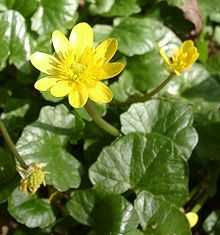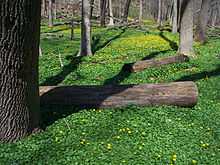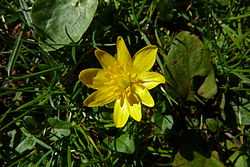Lesser celandine
| Lesser celandine | |
|---|---|
 | |
| Scientific classification | |
| Kingdom: | Plantae |
| (unranked): | Angiosperms |
| (unranked): | Eudicots |
| Order: | Ranunculales |
| Family: | Ranunculaceae |
| Genus: | Ranunculus |
| Species: | R. ficaria |
| Binomial name | |
| Ranunculus ficaria L.[1] | |
Lesser celandine (Ranunculus ficaria, syn. Ficaria grandiflora Robert, Ficaria verna Huds.) is a low-growing, hairless perennial flowering plant in the buttercup family Ranunculaceae. It has fleshy dark green, heart-shaped leaves and distinctive flowers with bright yellow, glossy petals. The plant is found throughout Europe and west Asia and is now introduced in North America, where it is often considered invasive. It prefers bare, damp ground and in the UK it can be seen as a common garden plant, an early harbinger of Spring.
Ranunculus ficaria exists in both diploid (2n=16) and tetraploid (2n=32) forms which are very similar in appearance. However, the tetraploid type prefer more shady locations and frequently develops bulbils at the base of the stalk. These two variants are sometimes referred to as distinct sub-species, R. ficaria ficaria and R. ficaria bulbilifer respectively.
Life cycle
According to Gilbert White, a diarist writing around 1789 in the Hampshire village of Selborne, the plants came out on February 21, but it is more commonly reported to flower from March until May, and is sometimes called the "spring messenger" as a consequence.
In non-native locations

In many parts of the northern United States and Canada, lesser celandine is cited as an invasive species. It poses a threat to native wildflowers, especially those ephemeral flowers with a spring-flowering lifecycle. It is mainly a problem in floodplain forests, where it forms extensive mats, but it also can occur on upland sites as well.[2]
In North America, the US National Park Service's Plant Conservation Alliance recommends avoiding planting lesser celandine, and instead planting native ephemeral wildflowers such as Asarum canadense, bloodroot, the native twinleaf (Jeffersonia diphylla), and various species of trillium as alternatives.[2]
Medicinal uses
The plant used to be known as Pilewort because it was used to treat hemorrhoids.[3] Supposedly, the knobbly tubers of the plant resemble piles, and according to the doctrine of signatures this resemblance suggests that pilewort could be used to cure piles. The German vernacular Skorbutkraut ("Scurvyherb") derives from the use of the early leaves, which are high in vitamin C, to prevent scurvy.[4] The plant is widely used in Russia and is sold in most pharmacies as a dried herb.
Medicines should be made from the dried herb or by heat extraction as the plant contains protoanemonin, a mild toxin. A single case was reported with acute hepatitis occurring after consuming a remedy made from lesser celandine. [5] However, the process of heating or drying turns the toxin to anemonin which is non-toxic and has antispasmodic and analgesic properties.
References in literature

The poet William Wordsworth was very fond of the flower and it inspired him to write three poems including the following from his ode to the celandine:
- I have seen thee, high and low,
- Thirty years or more, and yet
- T'was a face I did not know.
Upon Wordsworth's death it was proposed that a celandine be carved on his memorial plaque inside the church of Saint Oswald at Grasmere, but unfortunately the greater celandine Chelidonium majus was mistakenly used.[6]
Edward Thomas wrote a poem entitled "Celadine." Encountering the flower in a field, the narrator is reminded of a past love, now dead.
C. S. Lewis mentions celandines in a key passage of The Lion, the Witch and the Wardrobe, when Aslan comes to Narnia and the whole wood passes "in a few hours or so from January to May". The children notice "wonderful things happening. Coming suddenly round a corner into a glade of silver birch trees Edmund saw the ground covered in all directions with little yellow flowers - celandines".[7]
A reference appears in Tony Hendra's The Messiah of Morris Avenue: "He was kneeling on a carpet of violets and celandines." (p. 144)
J. R. R. Tolkien mentions this plant when he describes spring in Ithilien: "Great ilexes of huge girth stood dark and solemn in wide glades with here and there among them hoary ash-trees, and giant oaks just putting out their brown-green buds. About them lay long launds of green grass dappled with celandine and anemones, white and blue, now folded for sleep; and there were acres populous with the leaves of woodland hyacinths: already their sleek bell-stems were thrusting through the mould." The Two Towers, Book IV, Ch 7, 'Journey to the Cross-roads'
D. H. Lawrence mentions celandines frequently in Sons and Lovers. They appear to be a favourite of the protagonist, Paul Morrel;
"...going down the hedgeside with the girl, he noticed the celandines, scalloped splashes of gold, on the side of the ditch. 'I like them' he said 'when their petals go flat back with the sunshine. They seem to be pressing themselves at the sun.'
And then the celandines ever after drew her with a little spell."[8]
See also
References
- ↑ Linnaeus, Carl (1753). Species Plantarum. p. 550.
- ↑ 2.0 2.1 Swearingen, J., K. Reshetiloff, B. Slattery, and S. Zwicker (2002). "Lesser Celandine". Plant Invaders of Mid-Atlantic Natural Areas. National Park Service and U.S. Fish & Wildlife Service, Washington, D.C.
- ↑ http://botanical.com/botanical/mgmh/c/celles44.html
- ↑ http://www.naturescalendar.org.uk/wildlife/factfiles/flowers/lessercelandine.htm
- ↑ Strahl S, Ehret V, Dahm HH, Maier KP. "Necrotizing hepatitis after taking herbal remedies". Dtsch Med Wochenschr. Retrieved 25 February 2013.
- ↑ Miranda Seymour (2002). A Brief History of Thyme and Other Herbs. page 18
- ↑ C. S. Lewis (1950). The Lion, the Witch and the Wardrobe. End of chapter 11, beginning of chapter 12
- ↑ D. H. Lawrence (1913). Sons and Lovers. Chapter 6: Death in the family
External links
- Species Profile- Fig Buttercup (Ranunculus ficaria), National Invasive Species Information Center, United States National Agricultural Library. Lists general information and resources for Fig Buttercup.
- Video and narration about Lesser Celandine
| Wikimedia Commons has media related to Ranunculus ficaria. |